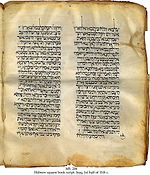Portal:Bible/Featured article/April, 2008

The Tanakh (Hebrew: תנ״ך) (also Tanach, [taˈnax] or [təˈnax], Tenakh or Tenak) is the Hebrew name of the Bible used in Judaism. It is a notariqon or acronym formed from the initial Hebrew letters of the Tanakh's three traditional subdivisions: Torah, Nevi'im and Ketuvim - hence TaNaKh. It is incorporated in the Christian Bibles, where, with some variations and additions, it is called the Old Testament. The Tanakh counts as one book what are sometimes counted as two in Christian Bibles (e.g. 1 and 2 Samuel, 1 and 2 Kings and so forth), and counts as one book all the twelve "Books" of the Twelve Prophets ("Trei Asar"). According to the Talmud, much of the contents the Tanakh were compiled by the Men of the Great Assembly ("Anshei K'nesset HaGedolah") a task completed in 450 BC, and have remained unchanged since that date. The Hebrew written text originally consisted only of consonants, together with some applied vowel letters used as vowels (matres lectionis). During the early Middle Ages Masoretes created a single formalized system. This was chiefly done by the Family Ben Asher, in the Tiberius school, based on the oral tradition for reading the Tanakh. It also included some of Ben Naftali and Babylonian innovations. These were codified in what is referred to as the Ben Asher System. It should be pointed out though, that while this was only codified much later, the pronunciation and cantillation is from an ancient source, since it is impossible to read the text without knowing pronunciation and cantillation pauses. The combination of a text (מקרא), pronunciation (ניקוד) and cantillation (טעמים) enable the reader to understand both the simple meaning, and the nuances in sentence flow of the text. (more...)
